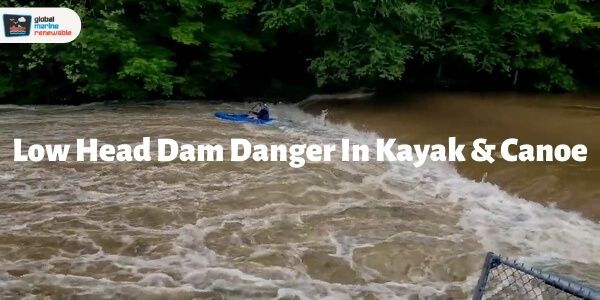Most experienced paddlers will plan the trip ahead before heading out for a kayak or a canoe ride in freshwater.
Usually, they have a fair idea of the weather, flow rate of the water, and the exact location of low-head dams on their route.
Whether the paddler intends to catch fish or simply take a tour in a river or stream channel, there are several dangers involved.
Table of Contents
Approaching a Low-Head Dam in a Canoe or Kayak – The Basics
Apart from the usual risks like getting caught in a storm or turbulent swirling current, paddling has other hazards as well.
Drowning in a low-head dam (also known as weir) is one such concern. It is not uncommon for beginner paddlers to fail to plan ahead.
Although, they can manage to evade a low-head dam by acting as soon as they see a low-end dam or feel the flow rate of the water rising.
Kayak Vs. Canoe – Which One Better for Recreational Fishing?
What is a Low-Head Dam?
A low-head dam is a man-made obstruction that runs across the width of the river. Naturally occurring low-head dams are irregular and do not consistently alter the water flow rate.
A man-made low head dam can be used to read parameters such as the volumetric flow rate by hydrologists.
A regular dam and a low-head dam (or a weir) do not perform the same functions. A regular dam holds water from flowing into the river.
In contrast, a low-head dam alters the flow characteristics of the water. Although the change in the flow characteristics of the water is subtle, a low-head dam can generate massive currents encompassing it.
Why is a Low-End Dam Dangerous for Paddlers?
No matter how good of a paddler (or a swimmer) you are, recirculating currents generated by a low-head dam will push you underwater.
According to a report by the Indiana Department of Natural Resources, the sudden change in the water flow rate causes people to bob up and down the stream. Most people fall off their kayaks and eventually drown.
What Should You Do When Approaching a Low-Head Dam in a Canoe or Kayak?
Before leaving for a kayak or a canoe ride, it is advised that you check the weather conditions in the region you are planning to paddle in.
The United States National Weather Service keeps track of weather conditions in all water bodies in and around the country. Visit the NSW website by clicking here.
Also, it is not a good idea to attempt to descend or go down a low-head dam. The impact can lead to major injuries and also can cause death by drowning.
If you happen to spot a low-head dam when paddling, your first course of action should be to slow down and cut a diagonal line towards the nearest bank.
Once you reach the shoreline, exit the river as soon as possible. Subsequently, you can portage the kayak or a canoe until you reach the nearest street or a dirt road that can safely lead you home. In case you didn’t know, portaging involves moving a water-based vehicle across the land.
Most paddlers would not mind lifting their kayak or a canoe upon their shoulders, but someone with bad knees will struggle.
If this sounds like you, carry a kayak trolley along on the trip (refer to the above image). A kayak trolley is compact enough to fit in the storage space. Some trolleys are motor mounted to make portaging offhand.
What to Do If You Cross the Point of No Return?
If you ever find yourself in a position where you have to confront a low-head dam, you must duck in and keep the center of gravity as low as possible.
Also, try not to paddle in the direction of the weir. Position the kayak perpendicular to the direction of the flow of water. Go along the lines of the weir, as straight as possible.
If the water flow is not high, you will manage to get to the shoreline unharmed. On the other hand, if you happen to fall into the “backwash,” keep your paddle ready for the brace.
Get out of the backwash as soon as possible. Most people struggle to get out of the backwash as the water beneath the dam spins in the clockwise direction. Hence, you must paddle as fast as possible.
Also Read: How To Get in and Out of a Kayak
Approaching a Low-Head Dam in a Canoe or Kayak The Bottom Line
The best strategy to deal with an unexpected encounter with a low-end dam is to avoid it entirely. Get to the shore and portage along the river. Only re-enter the water when you are far enough downstream.
To ensure your and your kayak’s safety, you must learn about kayak safety equipment and the process of tie down a kayak.
Most Helpful Safety Equipment Those are Required on Every Canoe and Kayak
Popular Posts:
- Tandem Fishing Kayak Buying Guide
- How To Choose a Kayak Paddle Under 100
- Best 00 Fishing Kayaks
- Best $300 Fishing kayaks
